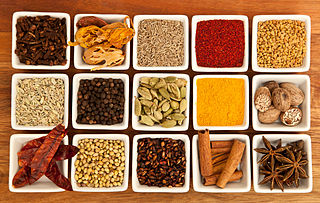 W
WTamil cuisine is a culinary style originating in the southern Indian state Tamil Nadu and other parts of South Asia like Sri Lanka. Both Vegetarian cuisine and Non-Vegetarian cuisine is popular among the Tamil people and has been since ancient times. However, meats along with rice, legumes and lentils are also popular. Dairy products and tamarind are used to provide sour flavors. On special occasions, traditional Tamil dishes are served in a traditional manner, using banana leaves in place of utensils. After eating, the banana leaves are then used as a secondary food for cattle. A typical breakfast meal consists of idli or dosa with chutney. Lunch includes Rice, sambar, Curd, kuzhambu, and rasam.
 W
WAdhirasam, kajjaya in Kannada, ariselu in Telugu, anarsa in Marathi, or arisa pitha in Odia) is a type of Indian sweet from Tamil cuisine, Kannada cuisine, Telugu cuisine and Marathi cuisine and Odia cuisine. The doughnut-like pastry has a long history of popularity in Kannada, Telugu, Maharashtra, Odisha, and Tamil civilization. They are similar in shape to vadai, but are not savoury and are eaten as a dessert.
 W
WAppam is a type of pancake, originating from South India, made with fermented rice batter and coconut milk, common in Kerala, Sri Lanka. It is also a dish in Tamil Nadu. It is eaten most frequently for breakfast or dinner.
 W
WBiryani is a mixed rice dish originating among the Muslims of the Indian subcontinent. It is made with Indian spices, rice, and meat usually that of chicken, goat, lamb, prawn, fish, and sometimes, in addition, eggs or vegetables such as potatoes in certain regional varieties.
 W
WBombay rava or ravva or rawa or sooji, is a durum wheat product and a form of semolina. Rava is made by grinding husked wheat and is used in Indian cuisine to make savoury dishes such as rava dosa, rava idli, upma, khichdis. There are also sweet dishes made from it, take for example rava ladoo, and sooji halwa in North Indian cuisine which is also known as rava kesari/ kesari bath in South Indian cuisine.
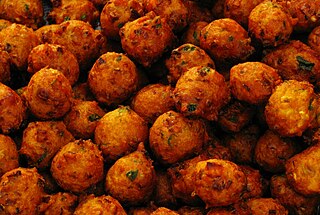 W
WBonda is a deep-fried South Indian potato snack that has various sweet and savory versions in different regions. Most common of which is "Aloo Bonda", and other region specific variations including potato replaced with sweet potato, tapioca, grated pineapple, green peas, paneer, etc.
 W
WChapati, also known as roti, rotli, safati, shabaati, phulka and roshi, is an unleavened flatbread originating from the Indian subcontinent and staple in India, Nepal, Bangladesh, Pakistan, Sri Lanka, East Africa, Arabian Peninsula and the Caribbean. Chapatis are made of whole-wheat flour known as atta, mixed into dough with water, oil and optional salt in a mixing utensil called a parat, and are cooked on a tava.
 W
WChettinad cuisine is the cuisine of a community called the Nattukotai Chettiars, or Nagarathars, from the Chettinad region of Tamil Nadu state in South India. Chettinad cuisine is perhaps the most renowned fare in the Tamil Nadu repertoire. It uses a variety of spices and the dishes are made with fresh ground masalas. Chettiars also use a variety of sun-dried meats and salted vegetables, reflecting the dry environment of the region. Most of the dishes are eaten with rice and rice based accompaniments such as dosas, appams, idiyappams, adais and idlis. The Chettiars, through their mercantile contacts with Burma, learnt to prepare a type of rice pudding made with sticky red rice.
 W
WChicken Chettinad or Chettinad chicken is a classic Indian recipe, from the cuisine of Chettinad. It consists of chicken marinated in yogurt, turmeric and a paste of red chillies, kalpasi, coconut, poppy seeds, coriander seeds, cumin seeds, fennel seeds, black pepper, ground nuts, onions, garlic and gingelly oil. It is served hot and garnished with coriander leaves, accompanied with boiled rice or paratha.
 W
WTamil cuisine is a culinary style originating in the southern Indian state Tamil Nadu and other parts of South Asia like Sri Lanka. Both Vegetarian cuisine and Non-Vegetarian cuisine is popular among the Tamil people and has been since ancient times. However, meats along with rice, legumes and lentils are also popular. Dairy products and tamarind are used to provide sour flavors. On special occasions, traditional Tamil dishes are served in a traditional manner, using banana leaves in place of utensils. After eating, the banana leaves are then used as a secondary food for cattle. A typical breakfast meal consists of idli or dosa with chutney. Lunch includes Rice, sambar, Curd, kuzhambu, and rasam.
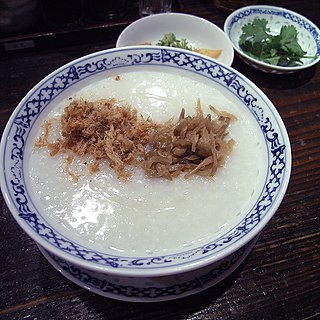 W
WCongee or conjee is a type of rice porridge or gruel eaten in Asian countries. When eaten as plain rice congee, it is most often served with side dishes. When additional ingredients such as meat, fish, and flavourings are added while preparing the congee, it is most often served as a meal on its own, especially for people who are ill. Names for congee are as varied as the style of its preparation. Despite its many variations, it is usually a thick porridge of rice largely disintegrated after prolonged cooking in water.
 W
WDahi vada is a type of chaat (snack) originating from the Indian subcontinent and popular throughout South Asia. It is prepared by soaking vadas in thick dahi (yogurt).
 W
WA dosa is a thin pancake or crepe originating from South India, made from a fermented batter predominantly consisting of lentils and rice. It is somewhat similar to a crepe in appearance, although savoury flavours are generally emphasized. Its main ingredients are rice and black gram, ground together in a fine, smooth batter with a dash of salt, then fermented. Dosas are a common dish in South Indian cuisine, but now have become popular all over the Indian subcontinent. Dosas are served hot along with chutney by tradition and sambar in recent times. Other accompaniments include chutney powder.
 W
WGhee is a class of clarified butter that originated in ancient India. It is commonly used in cuisine of the Indian subcontinent, Middle Eastern cuisine, traditional medicine, and religious rituals.
 W
WIdiyappam, also known as string hopper, nool puttu, or noolappam, chomai, indiappa is a rice noodle dish originating from the Indian states of Tamil Nadu and Kerala. It consists of rice flour pressed into noodles, woven into a flat disc-like shape and steamed. The dish also spread to Southeast Asia, where it is called putu mayam in Malaysia and Singapore, putu mayang in Indonesia.
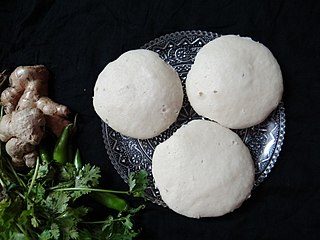 W
WIdli or idly are a type of savoury rice cake, originating from the Indian subcontinent, popular as breakfast foods in Southern India and in Sri Lanka. The cakes are made by steaming a batter consisting of fermented black lentils (de-husked) and rice. The fermentation process breaks down the starches so that they are more readily metabolised by the body.
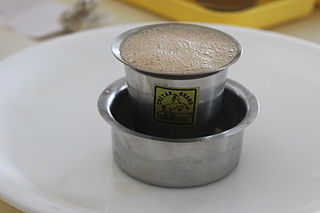 W
WIndian filter coffee is a coffee drink made by mixing frothed and boiled milk with the infusion obtained by percolation brewing of finely ground coffee powder in a traditional Indian filter. The drink is also referred to as Madras filter coffee, Kumbakonam degree coffee, Mylapore filter coffee, Mysore filter coffee, Palakkad Iyer coffee or South Indian Filter Coffee (Kaapi). Outside the country of India the term "filter coffee" may refer to drip brew coffee, which is a distinct form of preparing coffee.
 W
WKheer is a sweet dish and a type of wet pudding popular in the Indian subcontinent, usually made by boiling milk, sugar or jaggery, and rice, although rice may be substituted with one of the following: daals, bulgur wheat, millet, tapioca, vermicelli, or sweet corn. It is typically flavoured with desiccated coconut, cardamom, raisins, saffron, cashews, pistachios, almonds, or other dry fruits and nuts, and recently pseudograins are also gaining popularity. It is typically served as a dessert.
 W
WKootu (Tamil:கூட்டு) is a lentil and vegetable stew in South Indian, particularly Tamil and Kerala cuisines. The etymology for kootu derives from the Tamil word "kootu" which means "add" or "mixture/medley" i.e. vegetable added with lentils form the dish, which is semi-solid in consistency. The dish is noted for its nutty and complex flavors and textures, likely owing to the liberal addition of lentils and coconuts. It is typically less watery than sambhar, but more so than dry stir-fries. Virundhu Sappadu comes with a combination of boiled rice, sambar, rasam, curd, poriyal, kootu, appalam, pickles and banana. All kootus by default have some vegetables and lentils, but many variations of kootu exist:Poricha Kootu: A kootu made with urad dhal and pepper is called poricha kootu. Fried urad dhal, pepper, few red chilies, some cumin and fresh coconut are ground together. Moong dhal and the cut vegetables are cooked separately. Then, the ground paste, cooked vegetables and moong dhal are mixed and heated. Vegetables such as beans and snake gourd are common ingredients in this kootu. Araichivita Kootu: A kootu which has a powdered masala in it; the word araichivita in Tamil literally translates to "the one which has been ground and poured." The ground paste is a mixture of fried urid dhal, cumin seeds and coconut. Araichivita sambar: The chopped vegetables and toor dhal are cooked separately. Then, the ground paste, cooked vegetable and dhal are heated together. Then add the ground paste of coconut, Bengal gram, coriander, red chilies, a few pepper corns, a piece of cinnamon (optionally) - all roasted and ground. Season with mustard seeds and fenugreek seeds. Add the vegetables, including shallots, saute and then add water. Add tamarind extract, and then the ground paste and boiled dal. Served with rice.
 W
WKoozh is the Tamil name for a porridge made from millet. It is commonly sold by street vendors in Tamil Nadu.
 W
WKottu is a Sri Lankan dish consisting of diced roti stir-fried with scrambled egg, onions, chillies, spices, and optional vegetables or meat, such as mutton or chicken. A common dinner dish, kothu roti is also commonly available in cities outside of Sri Lanka with a significant Sri Lankan diaspora population, such as Toronto, London, Sydney, and New York City's Tompkinsville neighbourhood and certain Middle Eastern countries as well.
 W
WKullakkar rice is an ancient rice variety, grown primarily in India. It is one of the red rice varieties grown in India.
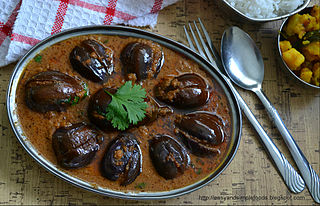 W
WKuḻambu, is a common dish in Tamil Nadu and Sri Lankan cuisines, and is a tamarind based dish that can include a variety of meat, vegetables, and in some cases, dal.
 W
WMadras curry or Madras sauce is a fairly hot curry sauce, red in colour and with heavy use of chili powder. Raita is often used as an accompaniment to the dish.
 W
WMasala dosa is a variation of the popular South Indian dosa, which has its origins in Tuluva Udupi cuisine Karnataka. It is made from rice, lentils, potato, fenugreek, ghee and curry leaves, and served with chutneys and sambar. It is popular in South India, it can be found in all other parts of the country and overseas. In South India, preparation of masala dosa varies from city to city. There are variations in Masala dosa like Mysore masala dosa, Rava masala dosa, Onion masala dosa, Paper masala dosa, Cheese masala dosa etc.
 W
WMulligatawny [] (listen ) is a soup which originated from South Indian cuisine. The name originates from the Tamil words miḷagāy or miḷagu, and taṇṇi. It is related to the dish rasam.
 W
WThe Munthiri kothu is a unique festival sweet from Kanyakumari District, Tamil Nadu, South India.
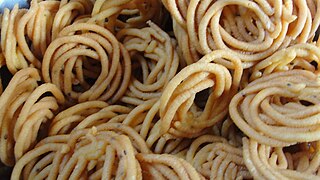 W
WMurukku is a savoury, crunchy snack originating from the Indian subcontinent. The name murukku derives from the Tamil word for "twisted", which refers to its shape. In India, murukku is especially popular in the states of Andhra Pradesh, Tamil Nadu, Karnataka, and Kerala. It is called murkulu or janthukulu in Andhra Pradesh. It is also popular in countries with substantial presence of Indian and Sri Lankan diaspora, including Singapore, Fiji, Malaysia, and Myanmar (Burma). Murukku, called sagalay gway in Burmese, is a common snack and is used as a topping for a regional dish called dawei mont di.
 W
WPaddu is an Indian dish made by steaming batter using a mould. It is named variously kuzhi paniyaram, paniyaram, paddu, guliyappa, yeriyappa, gundponglu, gunta ponganalu, or Tulu: appadadde, appe. The batter is made of black lentils and rice and is similar in composition to the batter used to make idli and dosa. The dish can also be made spicy or sweet with chillies or jaggery respectively. Paniyaram is made on a special pan that comes with multiple small indentations.
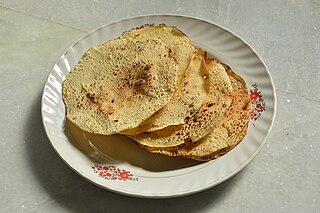 W
WA papadam, or poppadom is a deep fried dough of black gram bean flour, either fried or cooked with dry heat until crunchy. Other flours made from lentils, chickpeas, rice, tapioca, millet or potato are also used. Papadams are typically served as an accompaniment to a meal in India, Pakistan, Bangladesh, Nepal and Sri Lanka or as an appetiser, often with a dip such as chutneys or toppings such as chopped onions and chillies, or they may be used as an ingredient in sabjis.
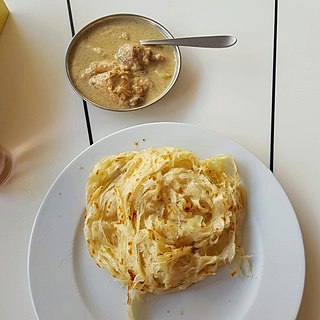 W
W'Parotta or Porotta is an Subcontinental layered flatbread made from Maida or Atta, alternatively known as flaky ribbon pancake. It is very common in Kerala, Tamil Nadu and widely available in other states like Karnataka, Maharashtra and countries like Malaysia, United Arab Emirates and Sri Lanka.
 W
WPongal or Huggi is a popular South Indian rice dish. In Tamil "pongal" means "To Boil" or "bubbling up". In Telugu and Kannada, pongali is a dish of rice mixed with boiled milk and sugar. Huggi is derived from the Old Kannada word Puggi meaning "bubbled up, ballooned".
 W
WPoṟiyal is the Tamil word for a fried, or sometimes sauteed, vegetable dish. The Kannada word for the same dish is Palya, The Telugu word for this dish is Koora, and in Malayalam it is "Mezhukupuratti". It is usually made by shallow frying shredded or diced vegetables along with spices. The preparation would normally involve frying mustard seeds, urad dal, onions and then the main vegetable, and finally adding turmeric, various spices, dried red chillis and coriander. In Tamil Nadu, shredded coconut would be added as a dressing.
 W
WPulihora, also known as puliyogare, puliyodarai,pulinchoru, kokum rice, or simply tamarind rice, is a very common and traditional rice preparation in the South Indian states of Karnataka, Andhra Pradesh, Telangana, Kerala and Tamil Nadu. Puli means 'tangy' or 'sour' in South Indian languages, referring to the characterizing use of kokum or tamarind as one of the main ingredients.
 W
WPuran poli(पुरणपोळी)/Holige(ಹೋಳಿಗೆ)/Obbattu(ಒಬ್ಬಟ್ಟು)/Bobbattu is an Indian sweet flatbread that originates from Maharashtra and southern India.
 W
WPuri is a deep-fried bread made from unleavened whole-wheat flour that originated in the Indian subcontinent. It is eaten for breakfast or as a snack or light meal. It is usually served with a savory curry or bhaji, as in puri bhaji, but may also be eaten with sweet dishes.
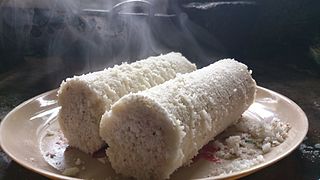 W
WPuttu is a breakfast dish eaten in the South Indian states of Kerala, Tamil Nadu and parts of Karnataka, as well as Sri Lanka. Puttu means "portioned" in Tamil and Malayalam. It is made of steamed cylinders of ground rice layered with coconut shavings, sometimes with a sweet or savory filling on the inside. Puttu is served hot with sweet side dishes such as palm sugar or banana, or with curries including dal, chickpea, mutton, fish, chicken, or beef curry.
 W
WRasam is a clear and spicy South Indian soup. It is eaten with rice or consumed as a soup. In a traditional South Indian meal, it can be part of a course that includes sambar rice and curd rice. Rasam has a distinct taste in comparison to the sambar due to its own seasoning ingredients and is fluid in consistency. Chilled prepared versions are marketed commercially as well as rasam paste in bottles.
 W
WSambar is a lentil-based vegetable stew/soup, cooked with pigeon pea and tamarind broth. It is popular in South Indian and Sri Lankan cuisines.
 W
WSevai, shavige or santhakai, or Saemia is a type of rice vermicelli popular in northern India as a dessert while popular in Tamil Nadu, Karnataka and some parts of Kerala as a snack. While typically made from rice, varieties made out of other food grains like wheat, ragi, and others can also be found. Sevai is a popular dessert in Bihar and Uttar Pradesh as a dessert after dinner.
 W
WThoothukudi macaroon is a special type of macaroon which was first made in the port town of Thoothukudi in the state of Tamil Nadu in India. While macaroons are traditionally made from ground almonds, Thoothukudi macaroons have cashew nuts as their major ingredient.
 W
WThoran (Malayalam: തോരൻ, pronounced [t̪oːɾan]; or upperi in Northern Kerala is a class of dry vegetable dishes combined with coconut that originated in the Indian state of Kerala. This common dish is usually eaten with rice and curry and is also part of the traditional Keralite sadhya.
 W
WUpma, uppumavu or uppittu is a dish originating from the Indian subcontinent, most common in Kerala, Andhra Pradesh, Tamil Nadu,Karnataka, Maharashtrian, Gujarat, Odia and Sri Lankan Tamil breakfast, cooked as a thick porridge from dry-roasted semolina or coarse rice flour. Various seasonings and/ vegetables are often added during the cooking, depending on individual preferences. Today it is popular in most parts of India and is prepared in various ways.
 W
WUthappam is a type of dosa from South India. In Tamil Nadu it is known as Uthappam (ஊத்தப்பம்), in Karnataka it is known as Uttappa (ಉತ್ತಪ್ಪ). In Kerala it is known as Oothappam (ഊത്തപ്പം) In Tulu it is known as Ootappa (ಊತಪ್ಪ) or Ootappo ( ಊತಪ್ಪೊ). Unlike a typical dosa, which is crisp and crepe-like, uttapam is thicker, with toppings. The name is derived from the Tamil words Appam and Utthia or Uttria, meaning Poured-Appam. Because Appam is cooked on a round bottom pan, whereas Utthia-Appam is cooked on a flat skillet. The Tamil ancient literature have a mention of it by its name. The classic breakfast of the Tamil residents consists of idli, dosai or uttappam mostly accompanied by sambar and chutney.
 W
WVada [vəɽɑː] or bada [bəɽɑː] is a category of savoury fried snacks from India. Different types of vadas can be described variously as fritters, cutlets, doughnuts, or dumplings. Alternative names for this food include wada, vade, vadai, wadeh and bara.
 W
WWatalappam is a coconut custard pudding made of coconut milk or condensed milk, jaggery, cashew nuts, eggs, various spices, including cardamom, cloves, and nutmeg, and sometimes thick pandan juice or grated vanilla pods.